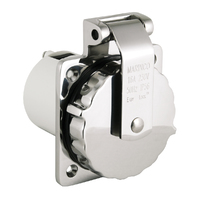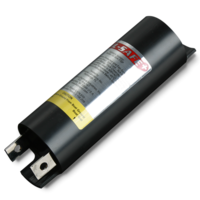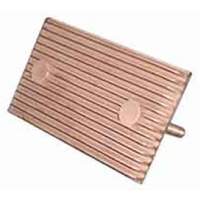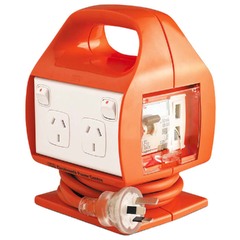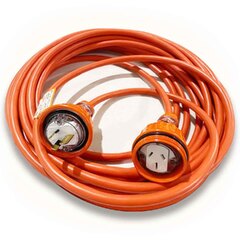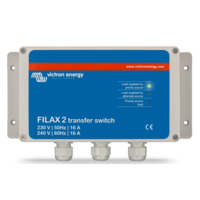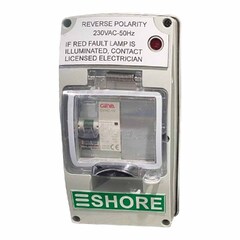AC Components
Galvanic Isolators (electrolysis blocker) block stray DC current between the vessel and shore power to prevent galvanic corrosion.
- Fail-safe design
- High fault current and lightning current ratings
Australian-made Moonraker brand Copper Earth Plate for either HF antenna installations or marine AC electrical systems.
The complexity of an AC power system can range from a simple system consisting no more than a shore power extension lead to keep batteries topped up through a small battery charger to a full on system using shore power, generator and inverter charger servicing multiple appliances, air conditioning ad so on.
The systems presented below offer solutions from the simple to relatively complex. Please note that the following discussion (and any resulting product development) is derived from an interpretation of Australian Standards publication AS/NZS 3004.2:2008 (Electrical Installations - Marinas and Recreational Boats). It is always the responsibility of the installing electrician to ensure the suitability of purpose and adherence to the appropriate standard for any specific installation.
Extension Cord Systems


The simplest system would comprise an extension lead (from a shore power dock pedestal) that leads on to the boat where "pluggable" AC appliances can connect directly to the extension lead. In a sense the installation is temporary - none of the system is a fixture to the vessel.
This type of system would be reasonably suitable to temporarily connect power to a battery charger or small appliance while at the dock. The diagram at top right shows the minimum requirement where the connection is protected by an RCD safety device at the dock pedestal.
Provided sufficient power is available from the vessel battery, an inverter might be used to provide limited AC power when away from the dock. By Australian standards, the inverter must be fitted with an AC Outlet and RCD safety device. In either case, power can not be wired to fixed AC power outlets or hard wired appliances. Only pluggable and portable devices can be connected. An example of an appliance might be a machine to assist people with sleep apnoea.
Fixed AC Power Systems
When all or part of an AC system is implemented as a fixture to a vessel, AS/NZS 3004 has special requirements. A fixture is defined as any device that is a permanent part of the vessel installation. Examples might include fixed AC power outlets, hot water systems, battery chargers, air conditioners and so on.
The minimum requirement for a basic fixed system will include:
- A shore power inlet facility including a double pole circuit breaker and reverse polarity indication
- Power outlets with double pole circuit breakers and switches
- An RCD safety device that protects all AC power outlet circuits
- A permanently fixed vessel earth electrode
- A MEN link on an installed genset or inverter
Double Pole Shore Power System
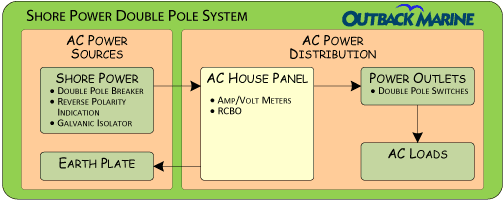 A basic AC system might only have a shore power connection and an AC panel. The shore power inlet has an indicator to warn if a reverse polarity condition exists. The AC panel has electrical metering and an RCBO (Residual Current Circuit Breaker with Overcurrent protection) for a power outlet circuit that provides connection points for AC loads. All AC power outlets must employ double pole switching.
A basic AC system might only have a shore power connection and an AC panel. The shore power inlet has an indicator to warn if a reverse polarity condition exists. The AC panel has electrical metering and an RCBO (Residual Current Circuit Breaker with Overcurrent protection) for a power outlet circuit that provides connection points for AC loads. All AC power outlets must employ double pole switching.
An earth plate is required as an electrode to connect the vessel earth to the surrounding sea water. However an issue with the earth plate is that it presents a problem associated with electrolysis that might allow stray DC currents to flow between ajacent vessels that can cause corrosion of underwater gear. Either an isolation transformer or galvanic isolator is used to block stray DC current - the latter being the least expensive.
When away from the dock, a small generator could be plugged into the shore power facilty.
Double Pole Shore Power - Inverter System
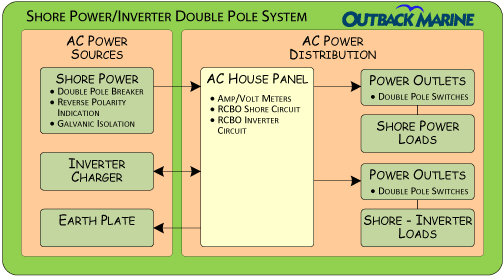 When away from the dock, an inverter can provide AC power to onboard appliances. The AC house panel has a dedicated circuit that provides power to electrical power outlets when using either shore or inverter power. Another circuit provides power to appliances only when shore power is available.
When away from the dock, an inverter can provide AC power to onboard appliances. The AC house panel has a dedicated circuit that provides power to electrical power outlets when using either shore or inverter power. Another circuit provides power to appliances only when shore power is available.
This separation would be required in the case of high current devices, for example a hot water system, where battery power would be insufficient to supply the load.
Either an inverter/charger or inverter can be used as long as it has the capability to switch to inverter mode if mains power is not present.
Double Pole Shore Power - Genset - Inverter System
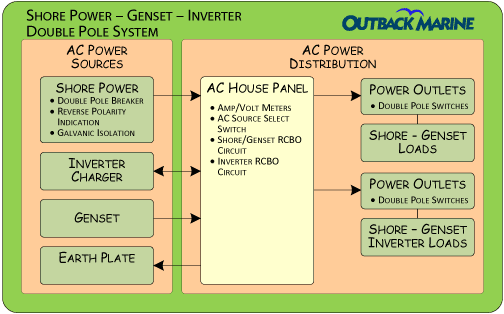 A permanent generator installation can be added to provide a fueled power source when away from the dock. This would be particularly relevant to power air conditioning or battery charging when alternate power sources are not available.
A permanent generator installation can be added to provide a fueled power source when away from the dock. This would be particularly relevant to power air conditioning or battery charging when alternate power sources are not available.
An AC source select switch is provided on the house panel to select the required mode of operation:
- Shore Power
- Off
- Genset
- Inverter
Single Pole Shore Power - Inverter System
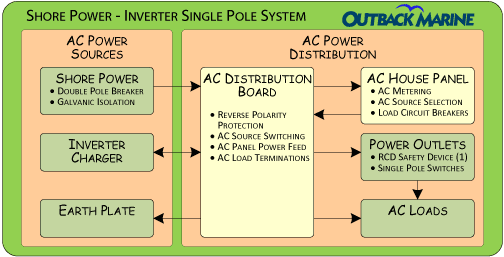 As vessel AC circuits increase in number, the circuit breaker panel is required to provide additional circuit breakers. Double pole breakers become inpractical as more are required on the AC panel. Single pole breakers become a better choice for larger systems.
As vessel AC circuits increase in number, the circuit breaker panel is required to provide additional circuit breakers. Double pole breakers become inpractical as more are required on the AC panel. Single pole breakers become a better choice for larger systems.
To comply with standards, an added requirement for a single pole system, is that an active reverse polarity protection circuit must be added to block shore power if the incoming polarity is incorrect. With this requirement, and the need to provide a reasonable termination facility for the increased number of circuits, an AC Distribution Board is introduced as an addition to the AC Panel.
Power is fed to the AC house panel according to the source selected. Individual circuit breakers on the panel feed power back to the AC distribution board where terminations are made for the vessel AC loads. If any AC circuit becomes overloaded, then the circuit breaker associated with that circuit will trip. Power will remain connected to other circuits. A selector switch on the AC house panel can select either shore or ship (inverter) power. A central off position will turn the inverter off and isolate shore power if connected.
A combined Inverter - Battery Charger which, as it's name implies, might replace the separate inverter and battery charger. As before, a small generator could be plugged into the shore power facility.
Single Pole Shore - Genset - Inverter System
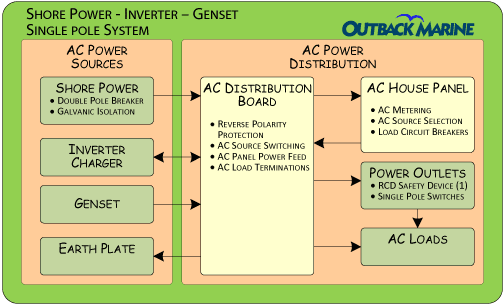 Vessels with air conditioning and / or electric cooking, will normally use a permanently installed generator set for powering the heavier and more constant AC loads when away from the dock.
Vessels with air conditioning and / or electric cooking, will normally use a permanently installed generator set for powering the heavier and more constant AC loads when away from the dock.
The AC distribution board now has an additional genset source. Because contactors are used for switching the AC source, any generator size from a few kilowatts to in excess of 20 kilowatts, can be accommodated by using the appropriately sized contactor. The source select switch on the electrical panel carries a relatively light current as it only switches the contactor coil current.

